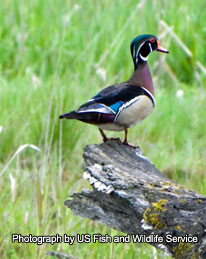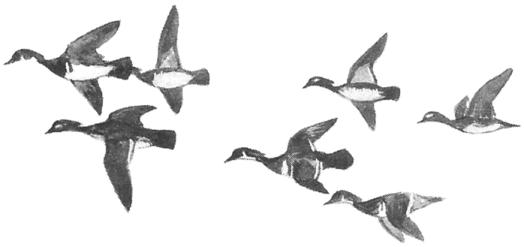Wildlife - Species

Species Specific Regulations
Wood Duck
Licenses: Hunting License required. Migratory Bird Hunting and Conservation Stamp (Federal Duck Stamp) that is validated by the hunter signing the stamp in ink across the face of the stamp
Limits: Please see Migratory Bird Regulations for any game zones restrictions or Limitations.
Wood Duck (Aix sponsa)

Description
The male wood duck is probably the most striking of all waterfowl species. Their iridescent chestnut and green coloring and ornate patterning make them almost impossible to confuse with other ducks.
Average Size
Wood ducks have an average length of 18 1/2inches and an average weight of 1 1/2 pounds.
Range
Found in all flyways; most numerous in the Atlantic and Mississippi flyways and fewest in the Central. Wood ducks are found throughout South Carolina all year long.
Preferred Habitat
Found in all flyways; most numerous in the Atlantic and Mississippi flyways and fewest in the Central. Frequents wooded streams and ponds; perches in trees.
Typical Flock Pattern

Wings

Food Habits
Wood ducks are omnivorous, feeding on seeds, fruit, and aquatic and terrestrial invertebrates. Flies through thick timber with speed and ease and often feeds on acorns, berries, and grapes on the forest floors.
Reproduction
Pair formation begins in late summer and continues through fall and into winter. Wood ducks nest in preformed cavities selected by the female located over water or nearby. They do not excavate their nest cavity, but instead used cavities formed when branches break off and heart rot of the trunk occurs. They infrequently use woodpecker cavities. Wood ducks will also readily use nest boxes. The female will then lay 6-16 eggs varying in color from white to tan.
Sound
Drakes call hoo-w-ett, often in flight and hens have a cr-r-ek when frightened.
Behavior
- They are early migrants; most of them have left the northern states by mid -November.
- Flight is swift and direct, and flocks are usually small.
- Commonly walk and perch on branches.
- Egg dumping is common among female wood ducks.
- Males are not territorial, but are protective of their mates.
- During the fall and winter months wood ducks can be found in small groups typically numbering between 15 and 50.
Citations, Publications and Literature
U.S. Fish & Wildlife Service, Federal Duck Stamp Office Presents: North American Waterfowl (PDF file)
Hepp, Gary R. and Frank C. Bellrose. 1995. Wood Duck (Aix sponsa), The Birds of North America Online (A. Poole, Ed.). Ithaca: Cornell Lab of Ornithology; Retrieved from the Birds of North America Online.
South Carolina waterfowl hunters 16 and older are required by state law to obtain a state migratory waterfowl permit and Migratory Game Bird permit. Both permits must be in the hunter's possession while hunting or transporting legal waterfowl. A state waterfowl permit is included with the Lifetime Senior, Lifetime Gratis and Disability Licenses. S.C. residents who hold a Lifetime Senior or Lifetime Gratis License are not required to have a Migratory Game Bird permit.
National Migratory Bird Harvest Information Program (HIP)
The waterfowl permits and HIP permits are available from select DNR offices and from hunting and fishing license agents.